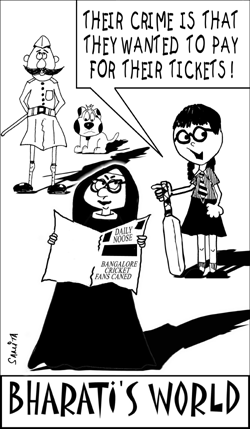West Bengal State University (WBSU), the state’s newest and youngest seat of higher learning, celebrated its third anniversary on February 25. In this short span of time this fledgling university — the 18th in West Bengal — has experienced extraordinary twists and turns.
WBSU was promoted by the Communist Party of India-Marxist (CPM)-led Left Front government, which has been ruling in West Bengal (pop. 80 million; adult literacy 69 percent) continuously since 1977, by carving it out of the University of Calcutta (UCal, estb.1857) in 2008. With 153 affiliated colleges and an aggregate student population of 305,000, UCal had become too unwieldy. Therefore in an astute two-birds-with-one-stone move, the bankrupt Left Front government saved itself the expense of promoting a new greenfield university and responded to a long-standing demand of the electorate in North 24-Parganas — a hinterland district north of Kolkata — by plucking 59 colleges with an aggregate enrolment of 95,000 students out of the UCal cluster and transferring them to WBSU sited in Barasat, the district headquarters. Senior academic Dr. Ashoke Ranjan Thakur, former vice chancellor of the highly rated West Bengal University of Technology, Kolkata, was swiftly appointed vice chancellor in May 2008.
 With 35 faculties spanning the humanities and basic sciences and 95 professors/lecturers, and approximately 1,200 postgraduate students, WBSU began as a perfectly respectable medium-sized university with every-thing going for it. Adding taste to the stew, as it were, Thakur turned out to be a competent visionary with strong leadership qualities. Even as the infrastructural groundwork of academic and office buildings, students’ hostel facilities, power supply and laboratories were being planned, the new univer-sity’s academic life got off to a flying start almost simultaneously.
With 35 faculties spanning the humanities and basic sciences and 95 professors/lecturers, and approximately 1,200 postgraduate students, WBSU began as a perfectly respectable medium-sized university with every-thing going for it. Adding taste to the stew, as it were, Thakur turned out to be a competent visionary with strong leadership qualities. Even as the infrastructural groundwork of academic and office buildings, students’ hostel facilities, power supply and laboratories were being planned, the new univer-sity’s academic life got off to a flying start almost simultaneously.
But a good beginning is a job only half done. In communist-ruled countries and the country-sized state of West Bengal, “academic autonomy”, “freed-om of expression” etc are theoretical concepts. For the past three decades the grip of the CPM politbureau and the party’s apparatchiks, who have mass-ively infiltrated the entire K-Ph D education system, has continuously tightened. In this environment Thakur’s encouragement of overseas academic collaborations became suspect with foreign visiting faculty being increas-ingly disallowed. Moreover, interf-erence with faculty appointments became normative.
Against this backdrop, to nobody’s surprise on January 19 on the eve of WBSU’s third anniversary, Thakur put in his papers as vice chancellor. In his resignation letter to the governor M.K. Narayanan, ex-officio chancellor of WBSU, Thakur cited the desire to move from administrative duties into research as the motive. But it’s hardly a secret in Kolkata that CPM commissars at 6, Alimuddin Street (headquarters of the CPM) were less than pleased with him and forced his resignation. However it’s a measure of the declining popularity of the CPM in West Bengal’s academia — hitherto a party stronghold — that on February 27, 53 of 97 faculty members signed a memorandum addressed to Nara-yanan, requesting him to reject Thakur’s resignation.
“We are worried that losing such dynamic leadership will demoralise us and hamper academic interests. The pace of change and new developments that were encouraged by an environ-ment of trust and freedom (sic) would be halted. This could lead to a colossal misuse of human and economic resources to meet the demands of several vested interests,” said the memorandum. Thus far (February 28) Narayanan has remained non-committal on the issue.
Meanwhile elections to the state’s legislative assembly — in which the CPM is the under-dog — are due to be held within the next two months. If the CPM is routed by the Congress-Trinamool combine as per general expectation, the WBSU growth and development story could change.
Sujoy Gupta (Kolkata)